Know Before You Go: Stress-Free Ski Vacation Planning
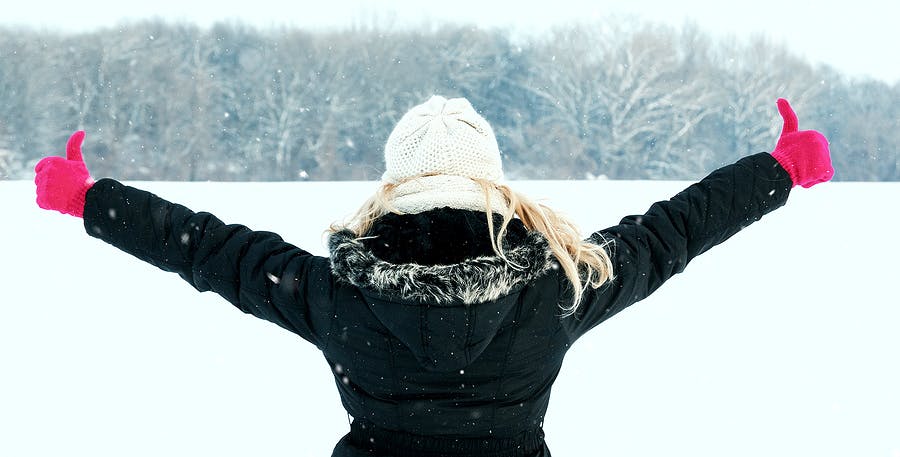
It's time: your best ski vacation ever is almost here.
Have you packed all the gear you need? Have you bought lift tickets? Accommodation? What about dinner reservations at the swankiest places in town? And your kids – will you be able to get a babysitter for them when you decide to hit the town for a night?
Okay, let's slow down. We're not here to scare you or to make you feel unprepared. Quite the opposite, actually. You see, when it comes to planning an epic ski vacation, there are dozens of things to consider, most of which need to be planned before you board the plane that's going to whisk you away to mountain town bliss. If you've booked ski vacations before, maybe you know what we're talking about: the lodging, the ski school lessons, the weather reports. If you haven't booked a ski vacation before, there's a good chance this all feels overwhelming. After all, how can you find out what you need to know when you don't even know what questions to ask?
The ski vacation is a century-old tradition in the modern world. Its roots can be dated back to excursions in the Swiss and French Alps, to cozy chalets tucked into mountainsides and halcyon days of cruising down empty slopes with majestic backgrounds of staggering peaks...
These days, ski vacations offer countless options in terms of place, price, and package. And whether you are booking a package deal or planning out every detail yourself, it's helpful to understand what is available before considering your options. When it comes to planning a ski vacation, it's often the details that aren't spelled out for you in the brochures that are going to be the most helpful. And we're here to help with that.
This guide is designed to help you understand what is involved in planning the ultimate ski vacation. You'll discover the best ways to travel, stay and dine; you'll find everything you need to know about discounted lift tickets and your kid's first day at ski school; you'll even find a section on how to keep your family safe on the slopes around crowds and inclement weather. So. Read on to get our comprehensive guide to stress-free ski vacation planning. And then go have the best ski vacation ever.
Travel
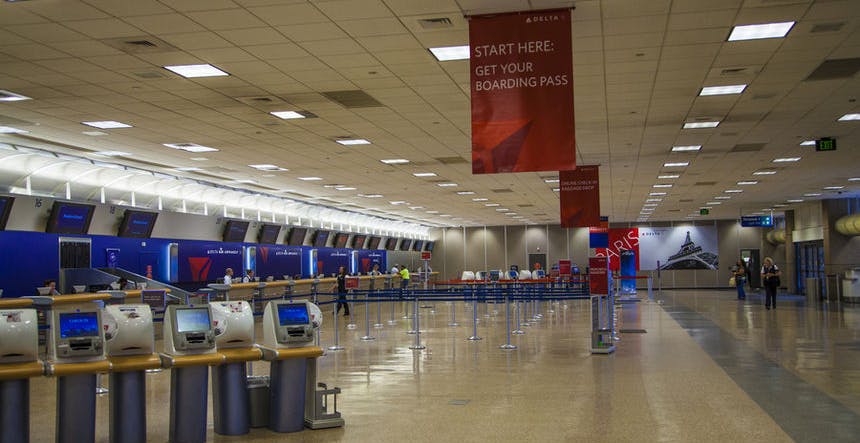
Getting to your destination (and getting around when you arrive) are the biggest concerns when starting to plan your ski vacation. It's likely clear whether you need to drive or fly, but there's also the best time for booking tickets, options for small regional airports, and rental car services to consider – not to mention package deals that bundle airfare with lodging. Here's the skinny on what you need to know for travel during your ski vacation:
Regional Airports
Flying into a regional airport means cutting the commute from major cities to your final ski destination. The perks? This cuts down on travel time and the hassle of lugging gear and switching vehicles multiple times. The downside? It's more expensive – usually $150-$200 dollars more per round-trip ticket.
Fly directly into Jackson Hole Airport to avoid the five-hour drive from nearby Salt Lake City; treacherous road conditions between the two places can seriously slow you down.
Consider flying intoTelluride Regional Airport rather than driving from Denver; the extra half day on the slopes is worth it.
The I-70 resorts like Aspen and Vail sport their own regional airports, but landing at Denver International and taking a mountain carrier is the best option for budget-friendly travel.
Rental Cars
One of the best perks of the modern ski vacation is that most destinations don't require a personal car. Hotels offer their own transportation services to/from the resort, and sometimes even airports. Town bus routes cover all major destinations within villages. That said, if you'd like to have total freedom to explore, or plan to spend more time outside the resort, consider renting your own car.
If you know you'll want a car and want to save on travel, look into flying to a nearby city, renting a car from the airport, and driving to your destination from there. This will be much cheaper than renting in a ski town.
Look for deals through airfare packages, AAA, and your airline rewards credit card.
Free shuttles
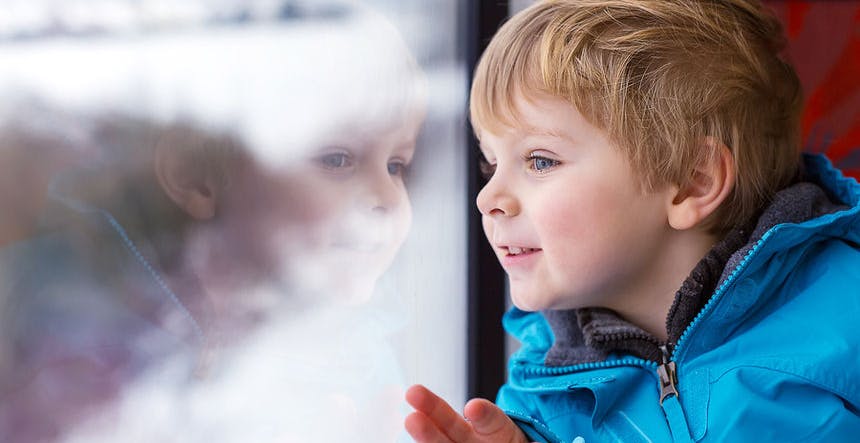
Established ski towns out West have excellent town shuttle systems, which are free around the resort's village and charge no more than a few dollars for longer routes. Your hotel or vacation rental will have specific information about routes. As for the East, shuttle services at resorts like Okemo and Stowe stop at specific locations around town for transport to the resort. Be sure to ask if your in-town accommodation are on the shuttle route.
Insider Tip: Weigh the costs of flying direct.
If you've got plenty of time (but not plenty of cash to burn), it may be worth landing in the closest city and shuttling the rest of the way.
How It Works: Ski Town Traffic
You won't hear the honking and chaos of New York City, but know that most resorts definitely have rush hour. It's from 3:45 – 5:30pm, when everyone's done for the day and leaving the resort. Consider staying to après for a couple of hours instead.
Question: What if I want to stay out late…will a shuttle be running after last call?
Town shuttle systems vary by resort, but most feature service until midnight, with some late-night exceptions on party-centered holidays. Uber and other services like it are scarce in mountain towns, so if you know you'll miss last shuttle, plan on calling a cab.
Gear

Gear: definitely something you don't want to forget while planning your ski vacation. There's not only the matter of looking cool while you ski, but also getting the gear that's practical for your needs and budget. If you're a seasoned skier heading to nearby mountains for a long weekend, you can skip this section. Otherwise, read on for the ins and outs of buying gear, renting gear, and how exactly you'll get all that gear to the slopes.
Buying
There are two reasons you should definitely buy gear: a) you'll have it long enough that it would cost less than renting, or b) you won't grow out of it anytime soon. A perk of buying your own boots and skis is getting both custom tailored to your needs and expectations (custom boot fitting, by the way, is a category in and of itself in the ski world). A downside is this is the most expensive option, so be sure you're getting your ski days in.
Budget at least 1 week between getting fitted at your local ski shop and heading to the slopes; this will allow time for custom boot fitting, mounting bindings, and ordering any equipment that's not in stock.
Kids grow out of skis and boots almost every year; look into purchasing second-hand skis to save.
Renting
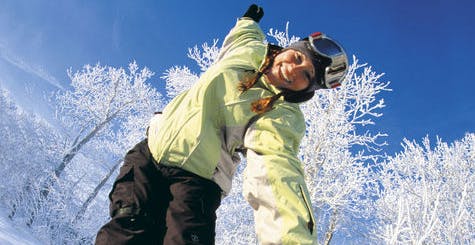
There are also two reasons you should definitely rent gear: a) you ski so infrequently that buying just doesn't make sense, or b) you've booked a ski vacation in a place where you'll need a different ski set-up than what you own. If you know that this is the one week this year - and maybe for the next few years - that you'll go skiing, skip the hassle of investing into a new set-up and let the rental crew at the local ski shop sort you out.
You can bring your super skinny carving skis to Colorado, but if a foot of powder falls overnight, consider renting fat skis for the day.
Be honest about your abilities when filling out the paperwork at the rental shop: this will ensure that they set you up with the best skis for you.
Ask ahead about overnight ski storage at the shop; you can often book ahead of time so you don't have to beat the crowds at the end of the day to swipe a ski locker.
Insider Tip: Look into direct rental deals with your hotel.
If you decide to rent your equipment once you get to your destination, check in with the hotel beforehand about their services. They often partner with local ski shops who offer on-site fittings and rental at the hotel.
How It Works: Ski Valet
Ski valet services bring the rental shop to you. They partner with hotels so you don't have to coordinate separately. If you are staying at a private house, call the service to reserve your equipment and they'll schedule a time to drop by your lodging and be sure it fits.
Question: Isn't rental gear junky?
Rental gear can be junky if you get it from a junky shop. That said, major resorts maintain their equipment with utmost care: they want it to last, after all. If you have any doubts, ask a concierge which shop they recommend, and know that you always have a choice in the gear you choose.
Lift Tickets

Have you ever been intimidated by the astronomical lift ticket prices listed on resort websites? $130 for a full day, $90 for just the afternoon? While lift ticket prices fluctuate slightly depending on day of the week or time of the season, for major resorts they hover around the $100 mark. But you might not know that there are lots of ways to score discounted tickets, and purchase lift tickets specific for your skiing needs. Read on for the details.
Options
The single, full day lift ticket is actually the one you are least likely to buy: simply put, there are others that more specifically suit your ski vacation needs, and for much better deals. Book a 3 day ticket and you'll save up to 10% at most resorts; book 7 days and save more. The half day ticket is worth it if you're sleeping in past noon, or the tickets are inclusive of a lodging deal.
If you're a beginner, look into a pass good for lower mountain lifts, which can cost less than half of a normal all-terrain ticket.
If you're booking the kids a lesson at ski school, purchase the lift ticket at the same time as the lesson to save.
Consider multi-resort passes if you want to explore various mountains this winter. The Vail Resorts Epic Pass ($729) grants unlimited skiing at 11 resorts. The Mountain Collective Pass ($499) is good for 2 days of skiing each at Whistler Blackcomb, Stowe, Jackson Hole, Taos, and more.
Discounts
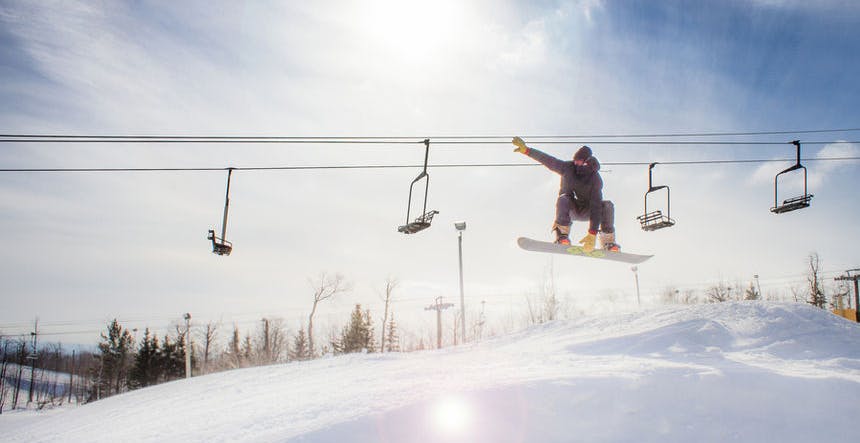
Ski industry insiders love to spread the love when it comes to hosting. If you're a member of ski patrol or ski school at your home resort, bring ID along to the ticket window on your ski vacation for up to 50% discount on lift tickets. Seniors and college kids, you qualify for discounted rates as well.
At most major resorts across the country, kids 5 and under ski free (but you still have to take them to the ticket window to get them a lift pass); for multi-day vacations with slightly older kids, it may be worth it to purchase a junior season pass.
Check resort websites for ongoing special offers, like Jackson Hole's limited-time offer for half-off lift tickets to season pass holders of any other resort.
Be honest with how much you want to ski on your vacation. Don't mind skipping a day to do some shopping and go to the spa? Great. Just don't buy a lift ticket that day.
Insider Tip: Reload Online.
Gone are the days of major resorts using the sticky tickets and wickets system. Here you'll get credit card sized piece of plastic loaded with your specific customer information that scans just before you load the lift. Resorts like Vail, Stowe, and Mammoth offer options to reload your pass online so you don't have to wait in line at ticket windows. Ever.
How It Works: RFID
RFID (radio frequency identification) passes are common at US and European ski resorts. If this is your first time using an RFID pass, here are a few tips: keep the pass in a jacket pocket (not pants) so that the scanner can read it. Do not keep the pass next to your cell phone; this will interfere with its frequency. Don't try to pass it back to a friend – it's unethical, and the pass also won't read twice within such a short amount of time.
Question: When should I buy my lift tickets?
Buying lift tickets is like buying airline tickets: if you're willing to commit, and can therefore book well in advance, do it. Save 25% - 45% on day tickets and multi-day passes when purchasing online just 2 weeks in advance on sites like Liftopia.
Lodging
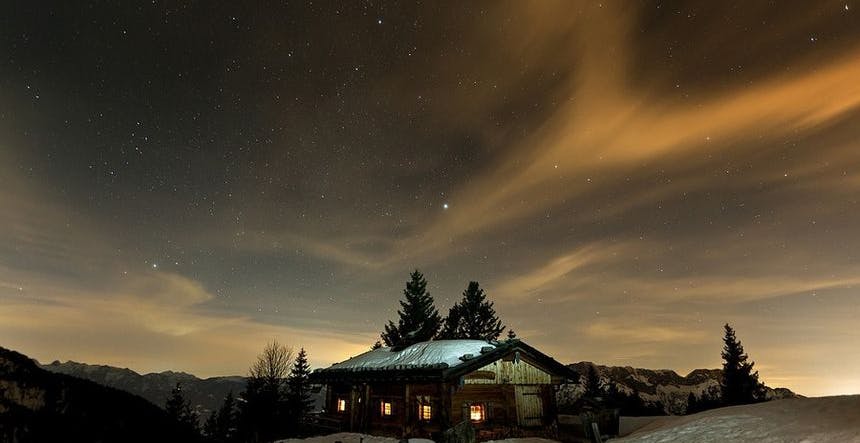
Your lodging is perhaps the most important aspect of your ski vacation off the slopes. After long days charging big lines (…or the bunny slope), you'll want the perfect space to kick back, relax, soak in a rooftop hot tub or get a massage. Whether you're booking luxury accommodation or a simple slopeside condo, lodging options at ski resorts vary widely. Here are some things to consider:
Hotels
The main perk of hotels is the customer service – that and built-in activities, dining, and ski valet services. Some offer private shuttle services to get you to/from the mountain or town with ease. Kids love swimming in the heated pools after a day at ski school, and on-site spas are perfect for parents who want to wind down after hitting the slopes.
Consider booking a B&B for a more personal, homey atmosphere and home-cooked meals. The Ruby at Crested Butte is one of the best in Colorado for gorgeous rooms and affordable luxury.
Some hotels offer dormitory rooms for hardcore skiers on a budget; book a bed at Alta's Peruvian Lodge for clean simplicity and slopeside ease.
Lodging/lift ticket packages are the most common in ski vacation deals; consider booking a hotel that includes lift tickets in the price – it will be cheaper than buying them separately at the ticket window.
Condos/Houses

We recommend renting a private condo (or house) if you want plenty of space and privacy. These digs are ideal if you'll be spending more time hanging out than partying out. Having a kitchen is also great for cooking your meals in and stashing snacks for hungry kids. If you're traveling with another family or tow, save big by going in on a house rental – you can find some that sleep up to twenty!
Some hotels offer private residences, so you can have your own house with access to all hotel amenities; check out a Four Seasons Resortresidence for the best of both worlds.
Private homes sometimes have outdoor gear available for use. Check in with the rental service to ask about sleds and snowhoes before bringing your own.
Slopeside vs. Town
Make this decision based on your needs and what feels most convenient. Ski-in/ski-out accommodation perks include: saving time before and after skiing, ease of not lugging gear back and forth, and no need for your own transportation to the slopes. Downtown accommodation perks include: close proximity to shopping, restaurants, and cultural activities, convenience of dropping off beginners exactly where they need to be, and cheaper rental rates.
If you opt for downtown lodging, check with the rental agency or hotel about transportation to/from the resort.
Check the fine print of ski-in/ski-out condos; some require a walk to the slopes, which can be difficult for beginners or young kids.
Insider Tip: Use the concierge.
The concierge will know much more about the resort and the town than you do, and it is their job to provide you with any information you need about rentals, activities, shopping, dining, etc. They might even give you some local tips on where to find the best powder and happy hour.
How It Works: Eco Hotels
Booking a boutique eco-hotel helps reduce your environmental footprint on your ski vacation. LEED-certified hotels meet strict requirements on energy use and waste reduction with organic mattresses, recycled building materials, and solar/wind energy. Check out Hotel Terra in Jackson Hole for environmentally conscious luxury.
Question: How do I get free lodging?
You get free lodging by booking multiple nights for your ski vacation, and getting a bonus night free. This is the most common lodging deal, and you can find the deal in virtually any major resort town in the country. (We can help you find one here).
Ski School
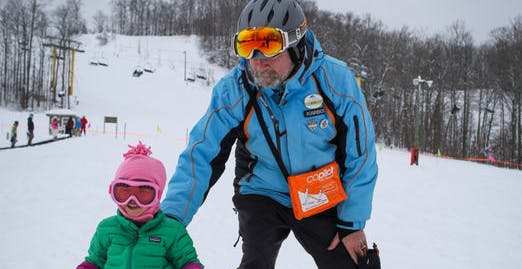
Like the resorts in which they operate, ski schools have transformed over the past two decades. In attempts to offer clients exactly what they want from ski lessons, mountain sports schools have developed specialty programs for park and pipe enthusiasts, multi-day camps for advanced skiers looking for steep thrills, and learn-to-ski bundles for first day beginners.
Kids Lessons
The best way for kids to learn to ski is through lessons; not only will they get the professional instruction they need to improve their skills and learn proper technique – kids also have a safe and fun space to practice and learn from other kids. Full-day lessons are the most popular: drop your child off in the morning for an all-inclusive day of skiing, lunch, and breaks when they need, then pick them up in the afternoon just before lifts close.
The 1-2 hour private lessons offered at eastern resorts are not so common in the West; opt for a half day instead.
Let the instructor know about any special needs, food allergies, or other details when you drop off your child.
Adult Lessons
Yes, you can still go to ski school as an adult – but you won't be in the same group lesson as your kid. Adult lessons, like kids lessons, are grouped by level, and instructors will help place you in the most appropriate group. All lessons build in time for drills and tasks, as well as time to practice those skills in your skiing. Half and full day group lessons are most common, while shorter private lessons may be available.
Professional instruction boosts confidence for adults; consider a lesson if this is something you'd like to work on.
To ski in a lesson with your kids, book a private.
Specialty Camps
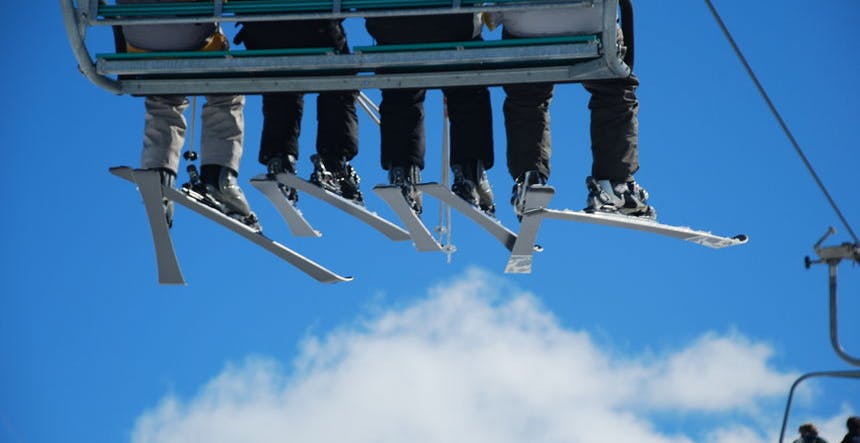
Specialty Camps are tailored to specific interests of different skiers. They can include multi-day camps just for women, focused freeskiing in steep terrain, park and pipe camps and even race instruction. Most span across 2-3 days and take place at specific times over the course of the season, so check mountain sports school schedules for dates and details.
The Ski Girls Rock Camp at Breckenridge, created by Lindsey Vonn, offers girls ages 7-14 opportunities to ski with dedicated female instructors to improve their skills and build confidence.
Snowbird's Big Mountain Kids Camp coaches kids on big mountain skiing tactics and safe exploration with trained instructors and visiting experts.
Insider Tip: Book early for specific instructors.
During peak vacation periods, the instructors get booked quickly for private lessons. If you have a referral from a friend for a specific instructor, contact him or her early. If you don't have the name of an instructor but know the type you'd like (for example, a "fun young female" for your 6-year-old daughter), let the ski school know.
How It Works: The Reluctant Kid
Is your kid the one who will be screaming and crying when you drop them off at ski school? No worries – instructors are pros at showing kids how fun skiing can be, even when their parents aren't around to watch. If the problem persists, you'll get a call. In the meantime, go enjoy the slopes.
Question: Should I book my kid a private or put them in a group lesson?
Most kids learn well – and quickly – in group lessons. If your child usually needs more one-to-one attention, consider booking a private. The entire day will be catered to your child's needs and interests. Keep in mind that a private lesson can be 6-7 times more expensive than a group lesson.
Safety
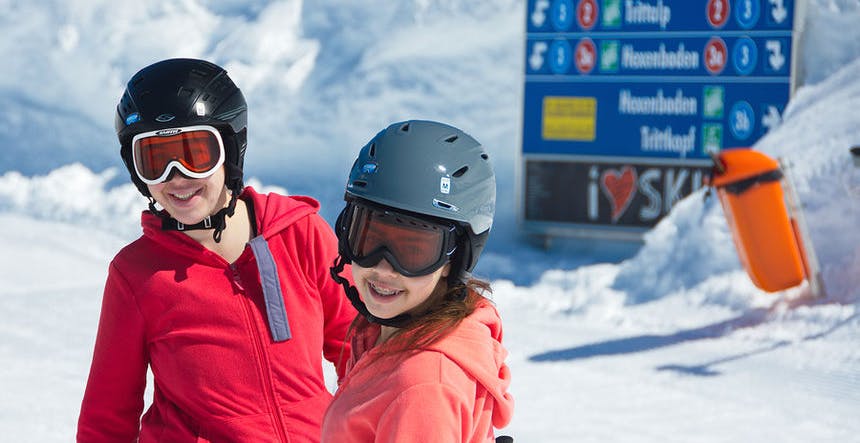
Safety is the first priority in skiing, and yet not so easy to guarantee.
Downhill skiing is by nature a high-risk sport: it basically involves strapping two metal planks to your feet and throwing yourself down a hill. The thrill is also, however, what makes it fun, and skiing is a beautifully unique way to explore the mountains in the winter. Following are a few things to look out for to keep things safe on the slopes:
Terrain Hazards
Be mindful of changes in terrain, exposed rocks and roots, and extreme steeps. Stay on terrain appropriate for your ability level, and if you aren't sure what that is, taking a ski lesson or checking in with a mountain host with a trail map are two good options.
Early and late season skiing proposes higher risk for exposed rock.
Be cautious on crowded slopes with blind knolls (the ones where you can't see the other side).
Note that terrain can change depending on factors like temperature and snowfall. Scroll down to the snow conditions section for more on this.
Lifts
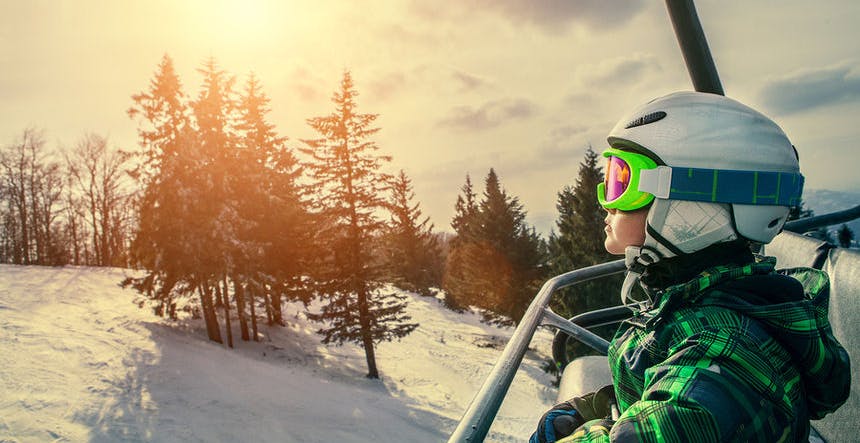
Loading, unloading, and riding lifts is a safety concern for children – especially small kids – who don't have the body awareness (or size) to ride lifts on their own. At least once each season a report of a child falling off the lift reminds us of the importance of riding them properly and being attentive to young skiers.
Kids should ride on the outside, so that lift attendants can help them get onto the lift properly.
Be sure that kids sit all the way back, and put the bar down for them.
Give kids a 3-2-1 countdown before unloading to be sure they don't sit up too early and get caught under the chair.
Weather
Incliment weather (or even bright sunshine) can heighten dangers such as visibility, frostbite, and sunburn. Note that the sun's UV rays are stronger at higher altitudes, and their reflection off the snow powerful enough to damage skin within minutes. Stay safe by preparing with these small tips:
Always wear sunscreen, even on cloudy days.
Cover up with a balaclava or face scarf to protect from wind and cold.
Beware that snow and wind seriously affect visibility; this can be scary for kids, especially when caught on the upper part of the mountain.
Insider Tip: Obey signs. Really.
Maybe it's in your nature to want to break the rules, but when it comes to ski resorts, the signs are there for your safety. If it says "closed," don't duck it. If it says "cliff area," be prepared to take a mandatory air. If it says "slow skiing zone," hit the breaks or you might lose your pass.
How It Works: Tree Wells
Tree Wells are hollow areas near the bases of trees that are covered with several feet of snow. When you fall into one, there is significant risk of suffocation, because the snow collapses into the hollow space around you. In trees, ski with a partner, and watch out for each other.
Question: How can I keep myself updated on weather conditions and safety?
Read the weather and grooming report in the morning before hitting the slopes. Check information boards at the base and summit for updates on wind and other weather hazards. Mountain hosts and information desks are helpful for daily safety tips.
Snow Conditions
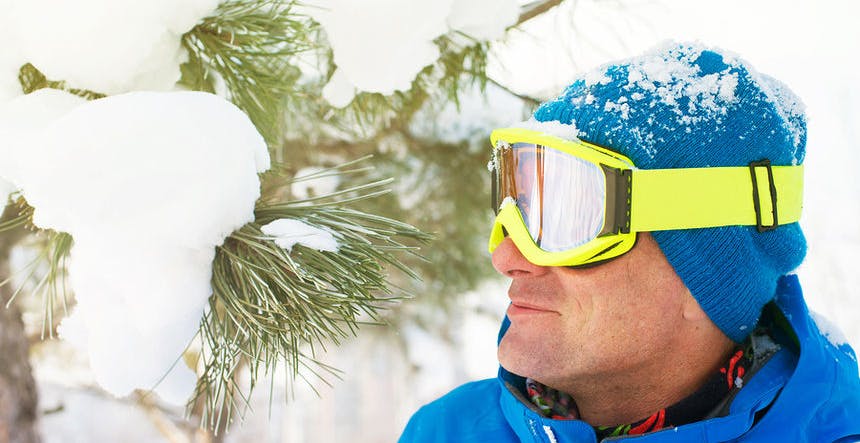
Snow conditions are a contributing factor to your ski vacation, no matter where you go. If you're headed out West, you might be asking for a 3 foot storm or bluebird days; if you're staying East, perhaps you're just praying for no rain. Here are the different snow types you can expect on the slopes (some are more pleasant than others):
Powder is fresh, natural snow that can vary in density; it's most common in areas with significant snowfall.
Packed powder is fresh groomed snow that's been packed down for optimal groomed conditions.
Ice is most common on steep slopes with manmade snow.
Corn snow is heavy, clumped-up snow common in spring and warm conditions.
Insider Tip: Avoid early mornings in the spring.
During freeze-thaw cycles, in which temperatures drop below freezing but climb into the high forties or above during the day, morning conditions can be extremely icy. The snow softens in the afternoon when temperatures warm up.
How It Works: Avalanche Control
You might hear ski patrol setting off avalanche control bombs in early mornings after significant snow fall. Thee vibrations are meant to trigger unstable snow preemptively so that a skier will not trigger it later in the day.
Question: Do I really need fat skis for powder days?
Fat skis (skis that are wide underfoot) are convenient on a powder day. They are specifically designed to allow a skier to "float" a bit in deep snow, rather than sink. You don't need them, but they will be more fun (and easier to maneuver) than your carvers.
Dining

The ski resort dining experience can be uber-exclusive, with fine steaks, wine pairings, and exquisite views to upstage any of your favorite city spots. On the flip-side, it can mean casual beers at ski bum bars with parmesan fries and a live band jamming in the background. Wherever you go, you'll have your pick of either (and anything in between).
On-Mountain Dining Options
When you book a ski vacation at a world-class resort, you get your pick of various midday dining experiences. The classic ski lodge cafeteria can still be found, but specialty cafes and fine dining options also abound. Slopeside hotels usually feature one or two restaurants as well.
Book reservations during peak periods to ensure your family has a good spot to eat for lunch.
Picnicing is (still) a great option on sunny days: pack some sandwiches and snacks and find a table outside for a laid-back lunch.
Fine Dining
Ski towns pride themselves on serving fresh, locally inspired cuisine in rustically elegant settings. You may very likely walk into an ultra-exclusive restaurant in Aspen or Jackson Hole to find local couples dressed in their finest jeans and cowboy boots, enjoying a fantastic meal. It's all part of the fine dining charm, and we highly recommend you see it for yourself.
Ask a concierge or a friendly local about the finest spots to dine, and make a reservation as soon as possible.
Some dining options offer an entire experience, like the Game Creek Restaurant in Vail, whose remote location is only accessible by Snowcat.
Ride the gondola at night up to Couloir, Jackson Hole's award-winning five-star restaurant featuring American bistro dishes with fresh local ingredients.
Cheap Eats
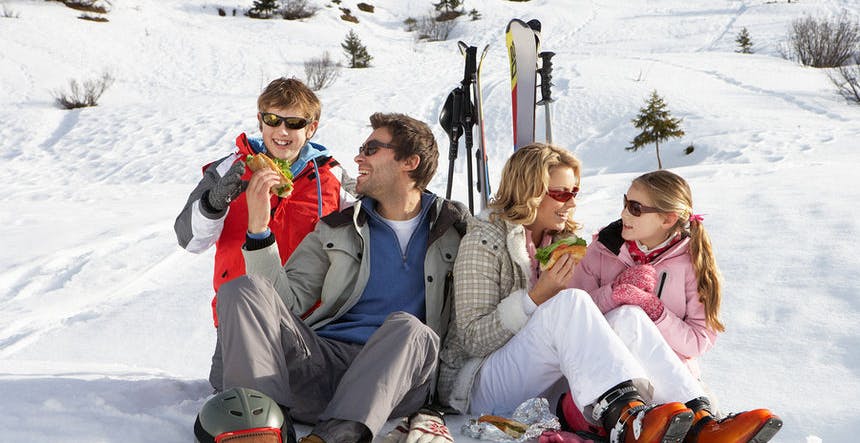
Note that ski towns always have good, cheap, local favorite spots amidst the luxury vacation scene. Pizza places and burger joints are your best bet for kids, and nearly all budget-friendly restaurants are ideal options for families looking for a quick bite.
The Blue Moon Bakery in Big Sky has wholesome sandwiches, pizzas, and baked goods at excellent prices
Stop by Mojo Café near Okemo for fresh Mexican food in a lively family setting; get there early -- they don't take reservations.
Insider Tip: Book a lunch reservation.
The lunch spots at resorts are packed from 11-1; eat outside these times for less stress in the lodges, or book a lunch resy at a slopeside restaurant.
How It Works: Grocery Services
Grocery delivery services are popping up in mountain towns like Park City and Steamboat, and we'll bet there's one available at your next vacation destination too. Order online, specify local and organic options when available, and get your groceries at the door the next day.
Question: Can I wear my ski boots to the restaurant?
Yes! You can wear your ski boots to a slopeside restaurant – they won't expect anything less. Just beware of slippery wood floors. At some fine dining restaurants, a boot warming service will offer you slippers to wear as they toast your boot liners dry (but this is rare, and arguably not totally necessary).
Childcare
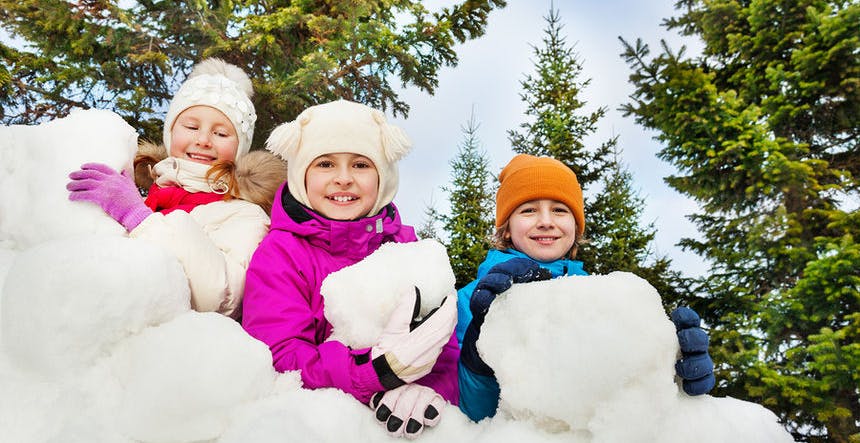
Ten years ago you might have been on your own to find a good babysitter on your ski vacation – that, or you'd have to bring your own nanny. Today, most major vacation spots have babysitting services, daycare centers, and even kids-only events that let you free to après for a couple hours.
Nanny Services
Book a private babysitter for your child through a reputable service for ultimate flexibility. Services do background checks, CPR training, and interviews to be sure you're getting a great babysitter.
The rates might be $2-$5 higher per hour than those in your hometown, but the sitter is paying a commission.
Check with the babysitting service about baby gear rentals as well so you don't have to pack a bag of extra books and toys from home.
Daycare
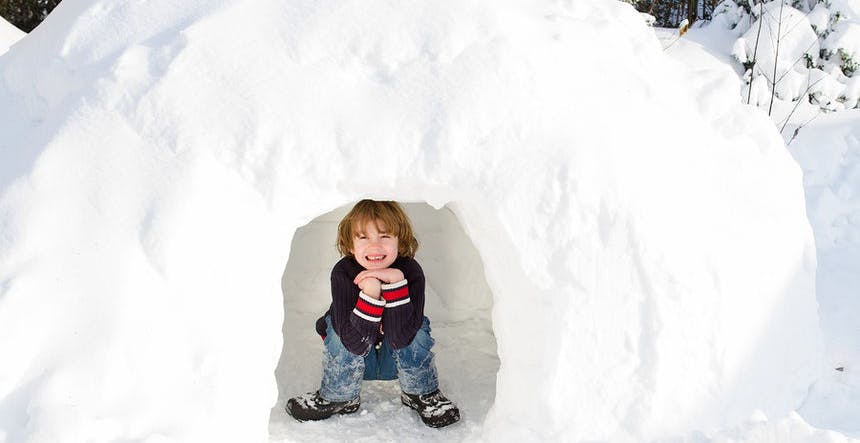
Ski schools offer daycare options where kids do not go outside to ski. They're cheaper than ski school and often include outside excursions, like gondola rides or playing on the snow castle.
Check the minimum age requirement for the resort's daycare: most are 6 months.
Send your kid with plenty of warm outdoor clothes and a change of socks if they plan to go outside.
Insider Tip: Book sitters early for vacation period nights.
Just because babysitting services employ dozens of sitters doesn't guarantee one will be available. Book as early as possible for holidays and vacation periods.
How It Works: A Day In Ski Resort Daycare
Daycare at ski resorts has the perk of being in the midst of outdoor fun, so as long as your child is old enough, they'll likely go outside for some quality fun in the snow. They will have snack time, coloring time, nap time, and maybe even a ride on the gondola.
Question: Should I send my kid to ski school, or book a babysitter?
Booking a babysitter is cheaper than paying for a full day of ski school. If your child doesn't want to ski all day every day, consider skiing with them in the morning, then booking a sitter for the afternoon so you can take some more runs on the slopes.
Shopping

Ski town shopping goes beyond the local trinkets and logo tees sporting slogans like "Got Oxygen? Elevation 11,725". The quaint villages of New England resorts boast handmade soaps, fine jewelry, and antiques; you can find the best cowboy boots in the country in ski towns of Wyoming and Montana; in Aspen and Vail, browse through collections of boutique clothing that will max out your credit card in one swipe.
Fine Art
The money in ski towns means plenty of funds for the arts, and fine art galleries feature unique pieces that are certainly worth viewing. Expect landscapes of old western towns and bold-stroked wildlife portraits.
Amy Ringholz of Jackson Hole recently opened a gallery of colorful wildlife paintings near the town square.
Fatali Gallery in Park City features unique photography acknowledging the spirit of nature and light.
Stop by Fabulous Furniture near Hunter Mountain for a look at Steve Heller's collection of sculptures and woodworkings.
Gear
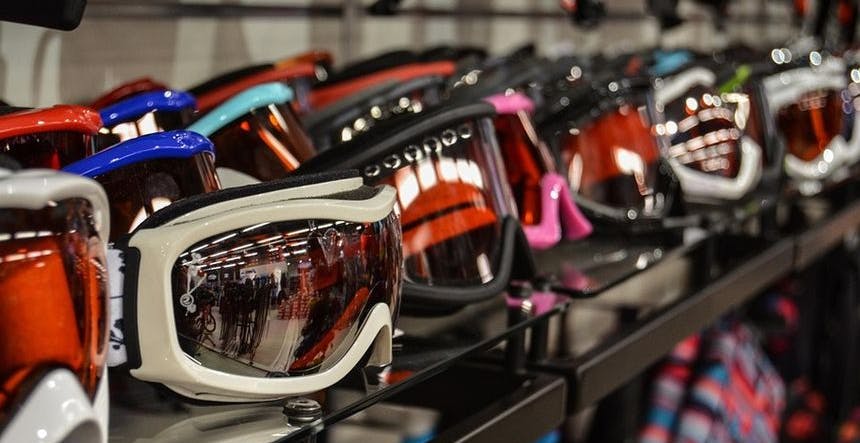
Whether you need gear or not, ski towns are the perfect place to buy, as they not only have huge selections of outdoor goods, but the highest quality of it. Ski towns are full of people who live the mountain lifestyle, so you can be sure to fine the best of the best and the good stuff that lasts. Perk: you also know it's cool.
Get fitted for new boots at The Boot Pro, mid-Vermont's preimier shop for custom boot fitting and high-quality gear.
The pros at Telluride Sports have been outfitting customers with outdoor gear for over 40 years.
Forget trekking down the canyon into Salt Lake City; pick up new goggles or a jacket at Cliff Sports instead.
Boutique Clothing
A ski vacation is the perfect opportunity to find unique clothing, and resort towns are bustling with independent shops featuring stunning handmade jewelry and clothing.
Shop at Gorsuch in Beaver Creek for designer ski parkas and fur boots.
Find funky accessories and designer dresses at Kali's Boutique in downtown Steamboat Springs.
Get a mountain-chic look at Sidestreet Boutique in South Lake Tahoe.
Insider Tip: Up-Level Your Souvenirs
Instead of a magnet or keychain with your loved one's name on it, consider an artsy item they could use in their home. It doesn't have to have the resort name plastered on it to have special meaning. Stores like Made in Jackson Hole boast cool, handmade gifts people love.
How It Works: Buying Local, Ski Town Style
Buying local means supporting the people who make their lives in that town, and supporting the stores that promote local artists and businesses. The place wouldn't exist without the people who call it their home, or the people who buy things at local stores.
Question: Should I still get a resort logo T?
Sure! How great that you have to option to shop for something a bit more sophisticated, but logo tees are still a great gift – especially too yourself. We love the retro trend that's hitting ski towns right now, and we'll bet you can find a great T with classic style.